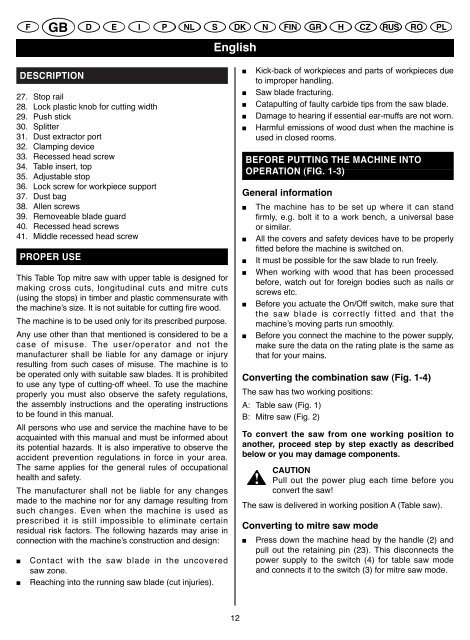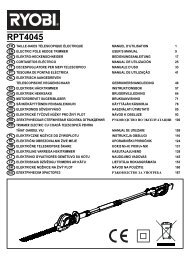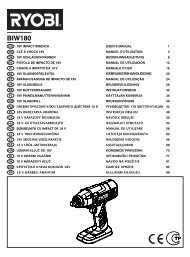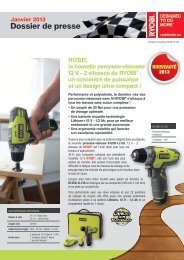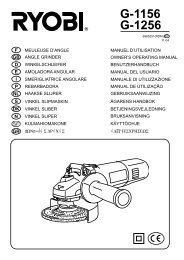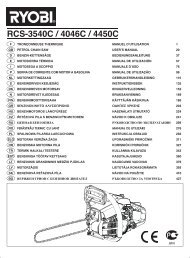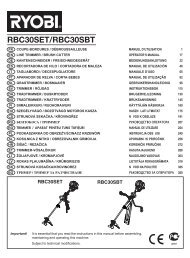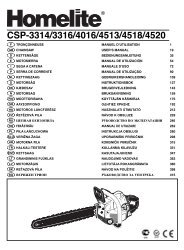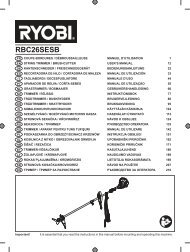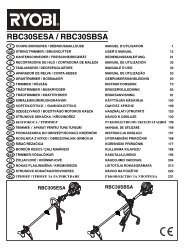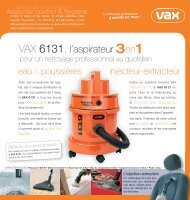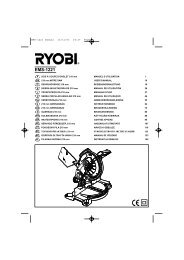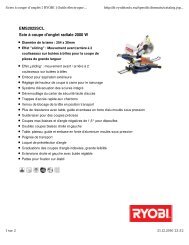ETMS-1426 manual.qxd - Ryobi
ETMS-1426 manual.qxd - Ryobi
ETMS-1426 manual.qxd - Ryobi
You also want an ePaper? Increase the reach of your titles
YUMPU automatically turns print PDFs into web optimized ePapers that Google loves.
F GB D E<br />
DESCRIPTION<br />
27. Stop rail<br />
28. Lock plastic knob for cutting width<br />
29. Push stick<br />
30. Splitter<br />
31. Dust extractor port<br />
32. Clamping device<br />
33. Recessed head screw<br />
34. Table insert, top<br />
35. Adjustable stop<br />
36. Lock screw for workpiece support<br />
37. Dust bag<br />
38. Allen screws<br />
39. Removeable blade guard<br />
40. Recessed head screws<br />
41. Middle recessed head screw<br />
PROPER USE<br />
This Table Top mitre saw with upper table is designed for<br />
making cross cuts, longitudinal cuts and mitre cuts<br />
(using the stops) in timber and plastic commensurate with<br />
the machine’s size. It is not suitable for cutting fire wood.<br />
The machine is to be used only for its prescribed purpose.<br />
Any use other than that mentioned is considered to be a<br />
case of misuse. The user/operator and not the<br />
manufacturer shall be liable for any damage or injury<br />
resulting from such cases of misuse. The machine is to<br />
be operated only with suitable saw blades. It is prohibited<br />
to use any type of cutting-off wheel. To use the machine<br />
properly you must also observe the safety regulations,<br />
the assembly instructions and the operating instructions<br />
to be found in this <strong>manual</strong>.<br />
All persons who use and service the machine have to be<br />
acquainted with this <strong>manual</strong> and must be informed about<br />
its potential hazards. It is also imperative to observe the<br />
accident prevention regulations in force in your area.<br />
The same applies for the general rules of occupational<br />
health and safety.<br />
The manufacturer shall not be liable for any changes<br />
made to the machine nor for any damage resulting from<br />
such changes. Even when the machine is used as<br />
prescribed it is still impossible to eliminate certain<br />
residual risk factors. The following hazards may arise in<br />
connection with the machine’s construction and design:<br />
■ Contact with the saw blade in the uncovered<br />
saw zone.<br />
■ Reaching into the running saw blade (cut injuries).<br />
I P NL S DK N FIN GR H CZ RUS RO PL<br />
English<br />
12<br />
■ Kick-back of workpieces and parts of workpieces due<br />
to improper handling.<br />
■ Saw blade fracturing.<br />
■ Catapulting of faulty carbide tips from the saw blade.<br />
■ Damage to hearing if essential ear-muffs are not worn.<br />
■ Harmful emissions of wood dust when the machine is<br />
used in closed rooms.<br />
BEFORE PUTTING THE MACHINE INTO<br />
OPERATION (FIG. 1-3)<br />
General information<br />
■ The machine has to be set up where it can stand<br />
firmly, e.g. bolt it to a work bench, a universal base<br />
or similar.<br />
■ All the covers and safety devices have to be properly<br />
fitted before the machine is switched on.<br />
■ It must be possible for the saw blade to run freely.<br />
■ When working with wood that has been processed<br />
before, watch out for foreign bodies such as nails or<br />
screws etc.<br />
■ Before you actuate the On/Off switch, make sure that<br />
the saw blade is correctly fitted and that the<br />
machine’s moving parts run smoothly.<br />
■ Before you connect the machine to the power supply,<br />
make sure the data on the rating plate is the same as<br />
that for your mains.<br />
Converting the combination saw (Fig. 1-4)<br />
The saw has two working positions:<br />
A: Table saw (Fig. 1)<br />
B: Mitre saw (Fig. 2)<br />
To convert the saw from one working position to<br />
another, proceed step by step exactly as described<br />
below or you may damage components.<br />
CAUTION<br />
Pull out the power plug each time before you<br />
convert the saw!<br />
The saw is delivered in working position A (Table saw).<br />
Converting to mitre saw mode<br />
■ Press down the machine head by the handle (2) and<br />
pull out the retaining pin (23). This disconnects the<br />
power supply to the switch (4) for table saw mode<br />
and connects it to the switch (3) for mitre saw mode.


